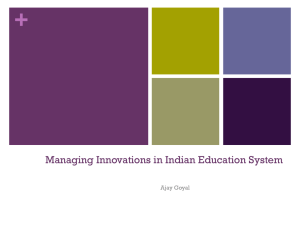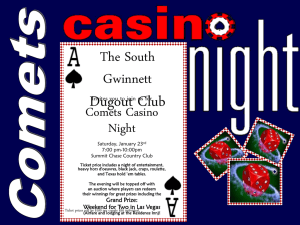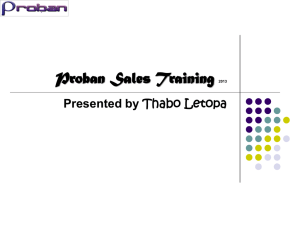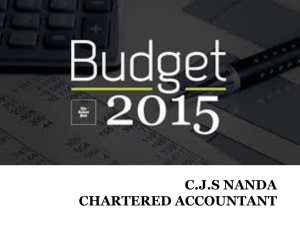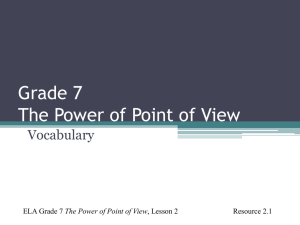behavioral finance_apr13
advertisement
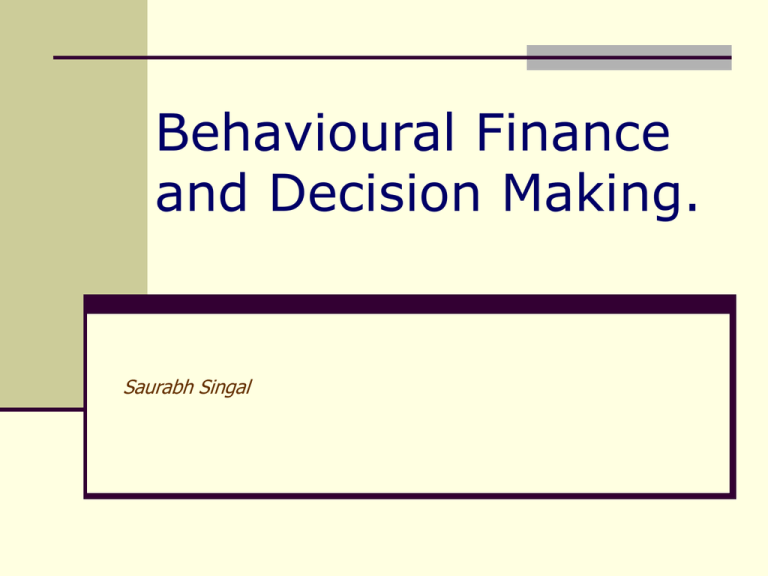
Behavioural Finance and Decision Making. Saurabh Singal Predicting is simple… The Dow Jones Industrial Average closed 1998 at 9181. As a price index, the Dow doesn’t include re-invested dividends. If the Dow were redefined to reflect the re-investment of all dividends since May 1896, when it commenced at a value of 40, what would be its value? -From a classic paper by Meir Statman and Roger Clarke In addition to your guess, please also make a low guess and a high guess, so that you are about 90% sure that the true answer is between the ranges. The answer is 652,230 But prone to error! “I’m sorry Mr. Kipling, but you just don’t know how to use the English language,” wrote the editor of the San Francisco Examiner in 1889. In rejecting the thriller The Day of the Jackal in April 1970, a publisher wrote to Frederick Forsyth, “ (Your) book has no reader interest.” A well-known American art critic said of Picasso in 1934: “(Picasso’s) prestige is rapidly waning and the custodians of his fame and his pictures are fighting a losing battle to elevate him to a position among the immortals.” Picasso painted many of his important works in the next forty years. In Movies and Music Marilyn Monroe was told early in her career, “You’d better learn secretarial work, or else get married.” The manager of the Grand Ole Opera told one young singer, “You ain’t going nowhere … son. You ought to go back to drivin’ a truck.” The singer was Elvis Presley. “We don’t like their sound. Groups of guitars are on their way out,” said a Decca Recording Company executive in 1962 in turning down the Beatles. In Technology Thomas J. Watson, the founder of IBM, said in 1943, “I think there is a world market for about 5 computers.” Ken Olson, the founder of Digital Equipment, stated in 1977 just before the PC revolution began, “There is no reason for any individual to have a computer in their home.” Bill Gates - 64 KB of RAM should be enough for everybody! Bernoulli and St Petersburg Paradox A fair coin will be tossed repeatedly until a tail first appears, ending the game. The jackpot starts at 1 rupee and is doubled every time a head appears. You win whatever is in the jackpot after the game ends. Thus you win 1 rupee if a tail appears on the first toss, 2 rupees if on the second, 4 rupees if on the third, etc. In short, you win 2k−1 rupees if the coin is tossed k times until the first tail appears. How much would you be willing to pay to enter the game? St. Petersburg Paradox (contd.) The probability the first tail occurs on the k-th toss is: 2-k How much can you expect to win, on average? With probability 1/2, you win 1 rupee; with probability 1/4 you win 2 rupees; with probability 1/8 you win 4 rupees etc. This sum diverges to infinity; "on average" you can expect to win an infinite amount of money when playing this game. According to traditional EXPECTED VALUE theory, under the assumption that the casino has infinite resources, no matter how much you pay to enter, you will come out ahead. Most people do not want to pay much to play this game. Bernoulli and Utility Thoery In Daniel Bernoulli's words: The determination of the value of an item must not be based on the price, but rather on the utility it yields…. There is no doubt that a gain of one thousand ducats is more significant to the pauper than to a rich man though both gain the same amount. Utility Theory (contd.) John von Neumann and Oscar Morgenstern enunciated that the Rational Economic Man or Homo economicus would act in a way to maximize expected utility. The six principles of Rational Decision Making theory are Ordering of Alternatives, Dominance, Cancellation, Transitivity, Continuity, Invariance. Maurice Allais showed Cancellation is violated and Kahneman & Tversky showed Invariance does not hold. How Behavioural Finance Differs from Classical Economics /Finance Simple Model of Economic behaviour Homo economicus Rational Man Economic Self-Interest governs decisions Perfect Information Rational model - how decisions should be made vs Real World - how decisions are actually made. Bounded Rationality Economists Veblen, John Maynard Keynes and Herbert Simon criticise Homo economicus as an actor with too great of an understanding of macroeconomics and economic forecasting in his decision making. They stress Uncertainty and Bounded Rationality in the decision making, rather than full information and Perfect knowledge. Bounded Rationality - People “satisfice” not optimize. Limits on both Knowledge and on Cognitive ability. Heuristics People use Heuristics – Rules of Thumb. Advantage - They reduce time and effort needed to make good decisions. Rough approximations are usually good enough. Disadvantage - in certain instances, this leads to Systematic Biases. Probability Weighting People overweight low probabilities and underweight high probabilities Ignore events of extremely low probability Treat extremely high probability events as certain. Decision models such as Prospect Theory use Probability Weighting functions. Allais Paradox Maurice Allais - 1988 winner of the Nobel Memorial Prize in Economics. Alternative 1A: 1 million for sure. Alternative 1B: A 10% chance for getting 5 million; 89% chance of getting 1million, and 1% chance of getting 0 Most people preferred the sure outcome of 1A, though 1B has a higher expected value. Allais Paradox (contd.) Alternative 2A: An 11% chance of getting 1 million and 89% chance of getting 0. Alternative 2B: A 10% chance of getting 5 million and a 90% chance of getting 0. Most people now choose 2B. This is strange, because if one prefers 1A, One should prefer 2A; and vice versa. Allais Paradox (contd.) Experiment 1 Gamble 1A Winnings $1 million Chance Experiment 2 Gamble 1B Winnings Gamble 2A Chance Winnings Chance 100% $1 million 89% Nothing $1 million Nothing $5 million Gamble 2B Winnings Chance Nothing 90% $5 million 10% 89% 11% 1% 10% Allais Paradox (contd.) To see this we should note that the two sets of lottery are similar in that 89% of the outcomes are identical. If you add an 89% chance of winning 1 million to each of the alternatives 2A and 2B they become identical to 1A and 1B The Winner’s Curse The winner in an auction quite often pays more than the fair value. The more the number of bidders, the greater chance that the winner will overpay. This is also true in corporate takeovers. How Evolutionary Wiring Makes Trading Inherently Tricky… Wired for survival How we handle panic, trauma, euphoria and depression Bad at probabilities Pattern Recognition – good for facial recognition bad for trading Cognitive and Emotional Biases Two Main Areas of Behavioural Finance Prospect Theory (includes Frame Dependence) Mental Accounting Prospect Theory Expected Utility Theory of von Neumann and Morgenstern is unable to explain why people are often simultaneously attracted to both insurance and gambling. Kahneman and Tversky found empirically that people underweigh outcomes that are merely probable in comparison with outcomes that are obtained with certainty. First, it replaces the notion of utility with value. Utility is usually defined only in terms of net wealth, value is defined in terms of gains and losses (deviations from a reference point). Prospect Theory Value Function normally concave for gains (implying risk aversion), commonly convex for losses (risk seeking) Value Function is steeper for losses than for gains (loss aversion) Thus, losses “loom larger” than gains. For instance, a loss of Rs. 500 is felt more than a gain of Rs.500. Most people hate to lose. People are risk averse in terms of gains but risk-seeking in terms of losses. Value Function Concave for Gains and Convex for Losses. Illustrations of Prospect Theory Problem 1: In addition to what you have, you are given Rs 100. you now have to choose between alternatives A and B Alternative A: A 50% chance of gaining Rs 100. Alternative B: A sure gain of Rs 50 84% respondents chose B, the sure thing. Prospect Theory Illustrated Problem 2: In addition to what you have, you have been given Rs 200 and have to choose between alternative C and D Alternative C: A 50% chance of losing Rs 100 Alternative D: A sure loss of Rs 50. This time 70% chose the uncertain alternative. Prospect Theory Both problems are numerically equivalent. But people do not behave in the way traditional expects posits they should. Given the chance to lock in a smaller gain versus a risky gamble with either no gain or an even higher gain, the majority choose the sure gain. Given the chance to lock in a sure loss versus a gamble where they could either avoid the loss totally or land up with a bigger loss, people would like to take the gamble. Prospect Theory (contd.) We have an irrational tendency to be less willing to gamble with profits than with losses. People feel a stronger impulse to avoid losses than to acquire gains. This means selling quickly when we earn profits but not selling if we are running losses. People often persist with losing stocks and sell their winners far too early to lock in a gain. Frame Dependence: The General’s Dilemma Imagine you are the commander in the army threatened by a superior force. Your staff says your soldiers will be caught in an ambush in which 600 of them will die unless you lead them to safety by one of two available routes. If you take route A, 200 soldiers will be saved. If you take route B, there is a 1/3 chance that 600 soldiers will be saved and a 2/3 chance that none will be saved. Which route should you take? Frame Dependence: The General’s Dilemma (contd..) Imagine that you are once again a commander in the army, threatened by a superior force. Once again, your staff tells you that if you take route A, 400 soldiers will die. If you take route B, there is a 1/3 chance that no soldiers will die and a 2/3 chance that 600 soldiers will perish. Which route do you choose?" Frame Dependence: The General’s Dilemma (contd..) Research by Kahneman and Tversky showed that most people would choose : route A in the first scenario because you would save 200 lives, but the same people end up choosing route B in scenario B because there is a 1/3 chance no lives are lost. Frame Dependence: The General’s Dilemma (contd..) The scenarios have the same end result in each option - but the two scenarios are framed differently. In one, the emphasis on how many lives are saved and the respondents want to be cautious and save as many lives as possible. In the second case, the emphasis is on how many lives are lost and most people try to gamble or be adventurous to avoid the certain death of 400. Mental Accounting Richard Thaler coined the term, defining it as “the inclination to categorise and treat money differently depending on where it comes from, where it is kept and how it is spent”. Gamblers who lose their winnings feel they lost nothing. Mental Accounting: Gambling with Earned Money vs Won Money People have a tendency to treat different cash flows differently depending on the source of the cash flow. A lot of people would not gamble with "hard earned money", but if they bet bet 5 rupees and win 10,000 thousand rupees with it, they might be less averse to gambling with all 10,000 rupees. Money is money, but many people would not mind betting or losing money that was won this way. While traditional finance suggests people should not distinguish between rupees in different pockets, in reality people do make the distinction. Mental Accounting: Theatre Ticket Scenario A. Imagine you have purchased a ticket to a theatre. On reaching the theatre you find that the ticket is lost and that it costs a hundred rupees to buy another ticket. Would you buy another ticket or go home? Scenario B. You arrive at the theatre and queue up to buy the ticket when you realize you have lost 100 rupees somewhere. Would you still buy the ticket or go home? Mental Accounting: Theatre Ticket It turns out that several people would go home in scenario A but the same people would pull out another 100 rupees in scenario B. In reality the outcomes are identical - you have lost 100 rupees and if you want to see the theatre you need to pay another 100 rupees. But people often have "mental accounts" - in this case a mental account for entertainment, for which they may be willing to spend 100 but not 200 rupees. Similarly, one could add a third scenario to the two above- you own a hundred shares of Suzlon which is down 100 rupees today, and will your answer change now? Cognitive Biases Overconfidence Bias Representativeness Bias Anchoring Cognitive Dissonance Availability Bias Self Attribution Bias Mental Accounting Confirmation Bias Hindsight Bias Framing Recency Bias Emotional Biases Endowment Effect Loss Aversion (explained by Prospect Theory) Regret Aversion (also by Prospect Theory) Lottery Effect (once again, Prospect Theory) Status Quo Emotional Bias: Lottery Effect Tendency to overweigh the impact of small probabilities and also to combine this with aversion to uncertainty. Certainty Effect – people will overpay to eliminate risks which have very small probability of occurrence Lottery Effect – People will overpay for the chance to make very large gains that are highly improbable. Cognitive Bias: Anchoring Anchoring is the name of the tendency to cling to irrelevant facts in the use of decision-making. With Genghis Khan in charge the Mongols ruled much of Central Asia before their leader led them on in an ill-fated campaign against Hungary, where he died. Question 1. Did these events happen before or after A.D. 151? Question 2. In what year did Genghis Khan die? Cognitive Bias: Anchoring (contd.) The first question is nothing more than an anchor. It is just there to put a date in your mind. Perhaps, it did not even seem right – too early. But it tends to weigh down your answer. Genghis Khan actually died in 1227 A.D. Anchoring: Housing Appraisal A group of randomly selected house brokers were taken to a house and asked to appraise its value. In addition the brokers received a ten-page information packet about the house, including a list price of $65,000. The average appraisal value that the group of brokers came up with: $67,800. Anchoring: Housing Appraisal (contd.) Then a second group of brokers were taken to the same house and given the same tour and the information package, but with one difference. The list price mentioned was $84,000. This time the average appraisal price returned by the brokers had moved to $75,190. This was more than $7,000 higher Anchoring: Wheel of Fortune Even when we know that we are susceptible to Anchoring, we are still not free from the effect. In another experiment a wheel of fortune containing numbers from 1 to 100 was spun and different groups of participants were asked if the percentage of African Nations was higher or lower than the number on the wheel. They were then asked to give their guess as to this percentage. Anchoring: Wheel of Fortune (contd.) The number on the wheel influenced the guesses o For the group that got 10 as the number on the wheel, the median guess was 25; o For the group that received 65 on the wheel, the median guess was 45. Cognitive Bias: Representativeness The Conjunction Fallacy - specific conditions are more probable than general ones. Linda is a 31 year old single, outspoken and very bright woman. She majored in Philosophy and as a student was deeply concerned with issues of discrimination and social justice and participated in peace march. What is more likely: A) Linda is a bank teller. B) Linda is a bank teller and a feminist. Most people chose B, even though compounding two probabilities means the correct answer must be A. Representativeness Bias As the amount of detail increases, the probability can only decrease but apparent likelihood increases with representativeness. Specific scenarios appear more likely than general ones because they are more representative of how we perceive particular events. Neglecting base rates is also part of representativeness. Cognitive Bias: Availability Death from Shark Attacks vs. falling airplane parts? The movie Jaws. People assess the probability of an event by the ease with which instances or occurrences can be brought to mind. Relative frequency of words that begin with the letter K (example knowledge) versus those where K (example, token) is the third letter. Most people guess the first is greater – even though the latter is three times more likely. Easier to recall or generate words beginning with a particular letter. Conclusion
